

It was a quiet February day in Seattle, Washington when Frank Lindsay ended the argument that he was having with his wife Audrey by bashing her over the head with a hammer, slashing her throat, sewing her body into a burlap bag, and then burying her behind the barn on their property.
 Grabbing his 12 year old foster daughter Pearl Grant, and a few hastily packed bags, Frank fled his home and high-tailed it south. He would later say that he took the girl with him because he thought that traveling with a child would give him a better cover story. It wasn”™t long before he realized that being on the lam with Pearl was a bad idea, and he subsequently abandoned her in a rooming house in Oakland.
Grabbing his 12 year old foster daughter Pearl Grant, and a few hastily packed bags, Frank fled his home and high-tailed it south. He would later say that he took the girl with him because he thought that traveling with a child would give him a better cover story. It wasn”™t long before he realized that being on the lam with Pearl was a bad idea, and he subsequently abandoned her in a rooming house in Oakland.
Frank finally landed in Napa, where he befriended the parents of 11 year old Beatrice Dellamore . He picked fruit alongside the family for several days, eventually convincing the couple to turn the girl over to him. Mr. Lindsay said that he knew a woman with money who could provide Beatrice with everything that she lacked as the child of itinerate laborers. In truth, he kidnapped the girl and took her with him to Los Angeles, where he checked in at the Hotel Cecil for a few nights.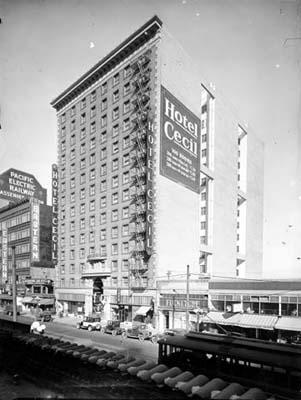
Then Frank did what so many other fugitives had done before him ”“ he sought refuge in a Bunker Hill rooming house.
Representing himself as Mr. R.F. Williams, he told people that Beatrice was his daughter. Lindsay kept the girl for two weeks in the rooming house, and then decided to put her on a bus back to Napa. Upon her return home, Beatrice was able to provide information about Frank, but the elusive spouse slaughterer continued to evade capture.
Audrey”™s brutal slaying and speculation about Frank”™s whereabouts were big news up and down the west coast. However, it wouldn”™t be professional law enforcement officers who would eventually locate Frank, it would be an amateur detective named William Sanborn.
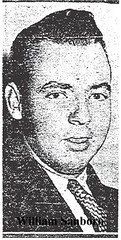 For a few of the months he was on the run, Frank had worked as a fry cook in the restaurant that Sanborn managed on Vermont. When Frank left the job, William lost track of him. William continued to devour his favorite true detective magazines, and in one of them he read a lurid tale about the grisly murder of a Seattle housewife. In the same magazine he found a description of the missing husband who was being sought for the killing ”“ and William strongly suspected that the wanted man was none other than his former cook!
For a few of the months he was on the run, Frank had worked as a fry cook in the restaurant that Sanborn managed on Vermont. When Frank left the job, William lost track of him. William continued to devour his favorite true detective magazines, and in one of them he read a lurid tale about the grisly murder of a Seattle housewife. In the same magazine he found a description of the missing husband who was being sought for the killing ”“ and William strongly suspected that the wanted man was none other than his former cook!
It was by chance that William bumped into Frank at another restaurant on Vermont where the absconder was again employed as a fry cook. Fueled by the spine tingling exploits of the detectives he idolized in his beloved magazines, Sanborn vowed that he would apprehend the killer on his own. During their past conversations, the restaurateur had learned that Frank was a jack of all trades. Not only was he a cook, he was also an accomplished plumber. Sanborn told Lindsay that he needed some work done at his home and, sweetening the pot with the offer of some under-the-table cash, Sanborn was able to get his plumbing repairs completed before he dropped the dime on the wife killer.

As an upstanding citizen and detective wannabe, Sanborn needed to be absolutely sure that he was pursuing the right man. He contacted the homicide squad and was handed a photo of Lindsay, which he immediately identified as an image of his former employee. In a move that was dangerous at best and completely insane at the worst, Sanborn then confronted Frank with the photo at the restaurant where he was working. Frank took the picture and held it in his fingers, thereby conveniently fingerprinting himself. When cops ran the prints, they matched those of the runaway murderer. Detectives turned up at the Stanley Apartments at 210 South Flower later that evening, and took Lindsay into custody without incident.
There were many facts about which Frank hadn”™t been forthcoming ”“ like his real name, which was discovered to be Charles E. Murphy, as well as his place of birth, which was not Massachusetts as he”™d claimed, but rather someplace in the UK. We should give the devil his due though, because at least he was truthful about having served in both the British and U.S. armed forces. However, what he”™d neglected to reveal was that he had deserted from both. And if all of those lies weren”™t enough, it was uncovered that Frank was already married when he met and married Audrey!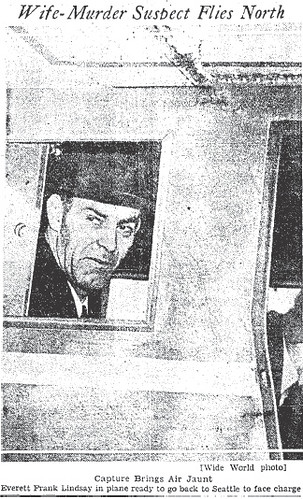
Because Frank had lied about most of the details of his life, police were skeptical of his claim that it was Audrey”™s nagging that had compelled him to spontaneously murder her. And the authorities also didn”™t buy his alternate version of Audrey”™s murder in which he was not the attacker, but instead was valiantly defending himself from certain death at the hands of his enraged wife! His story may have been more credible if he hadn”™t pre-dug the grave into which he”™d dumped Audrey”™s corpse.
It took them a while, but police finally untangled Frank”™s web of lies. They concluded that when Audrey had accused him of the criminal assaults on several young girls in the Seattle area (including attacks on their foster daughters), and then threatened to turn him in, Frank snapped and murdered her.
Frank was shackled and extradited from Los Angeles back to Washington, where he was tried and convicted for Audrey”™s murder. He was sentenced to 65 years in Walla Walla Prison.
The sound of the prison gates slamming shut behind him should have signaled the end of the story, but Frank would make news again in 1947.
Frank was on his best behavior in prison and would eventually earn trustee privileges. By January 1947, he was working as the cook in the warden”™s home. One day, Frank simply walked away from the prison and vanished. On the run for most of the year, he was finally recaptured in a restaurant in Denver, Colorado, where he was found plying his usual culinary trade.After his unsuccessful escape from prison, Frank would disappear from the newspapers entirely.

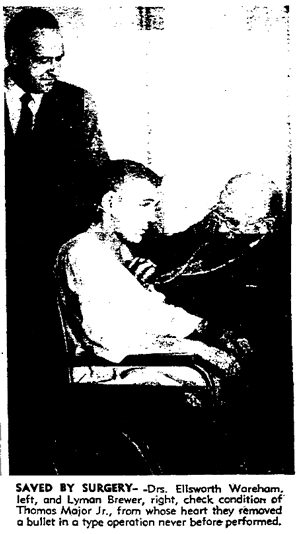
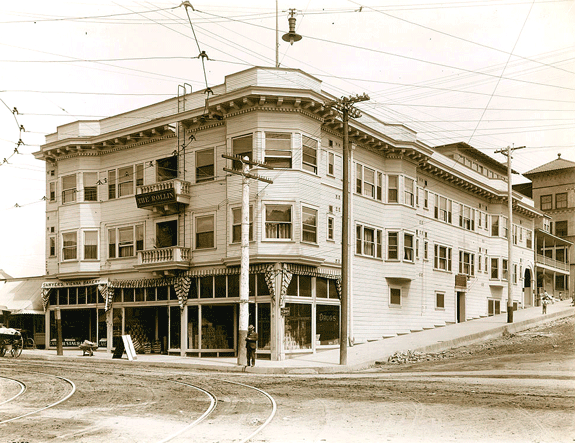



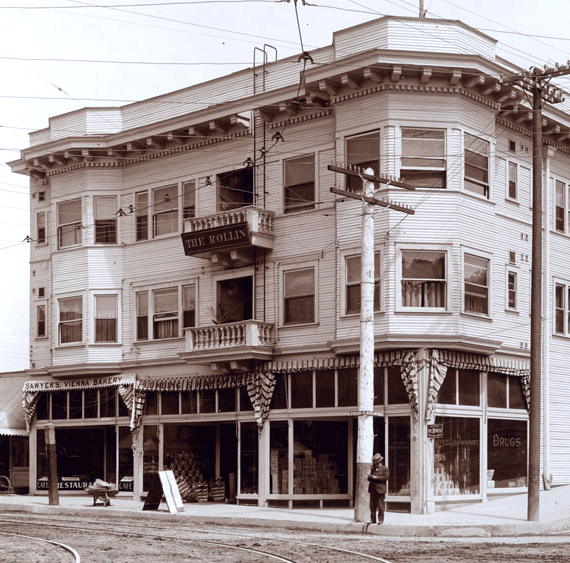

 When it rains, it pours. Which is probably a good thing, since rain will put out all that pesky fire.
When it rains, it pours. Which is probably a good thing, since rain will put out all that pesky fire.
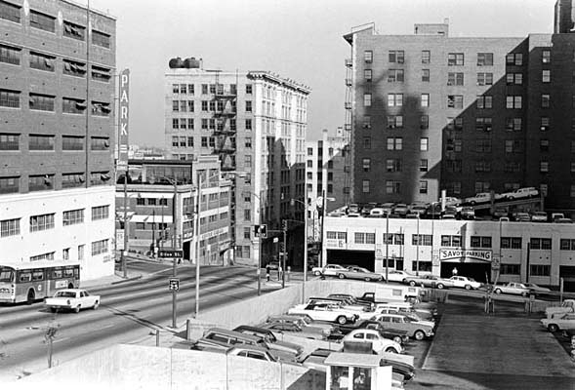
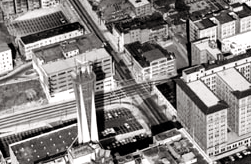 Remarkably, the Savoy still stands. The 600-car Mutual at left in the image above is now the foundation for
Remarkably, the Savoy still stands. The 600-car Mutual at left in the image above is now the foundation for 


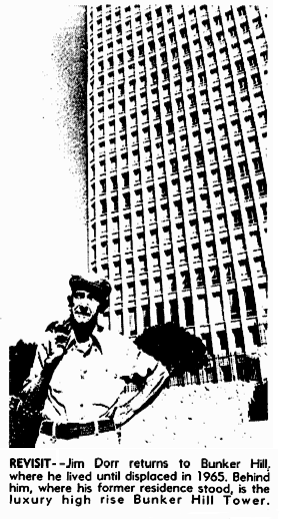 In November 1979, the Times ran a piece about Angelus Plaza, Bunker Hill’s subsidized housing project for seniors. For the article they dug up one of the original uprooted persons, a Jim Dorr, 73, who‘d been sent a notice by the CRA to vacate the Stanley Apartments on November 15, 1965. He‘s glad he saved those displacement papers all these years: HUD will give him priority in the otherwise random lottery.
In November 1979, the Times ran a piece about Angelus Plaza, Bunker Hill’s subsidized housing project for seniors. For the article they dug up one of the original uprooted persons, a Jim Dorr, 73, who‘d been sent a notice by the CRA to vacate the Stanley Apartments on November 15, 1965. He‘s glad he saved those displacement papers all these years: HUD will give him priority in the otherwise random lottery.
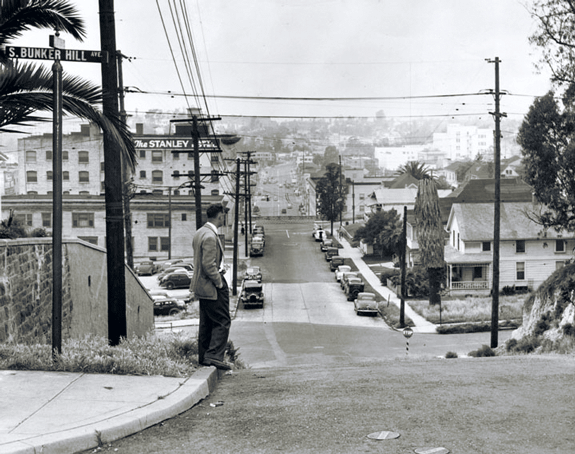

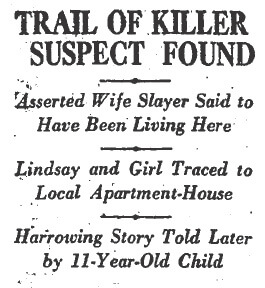

 Grabbing his 12 year old foster daughter Pearl Grant, and a few hastily packed bags, Frank fled his home and high-tailed it south.
Grabbing his 12 year old foster daughter Pearl Grant, and a few hastily packed bags, Frank fled his home and high-tailed it south.
 For a few of the months he was on the run, Frank had worked as a fry cook in the restaurant that Sanborn managed on
For a few of the months he was on the run, Frank had worked as a fry cook in the restaurant that Sanborn managed on 

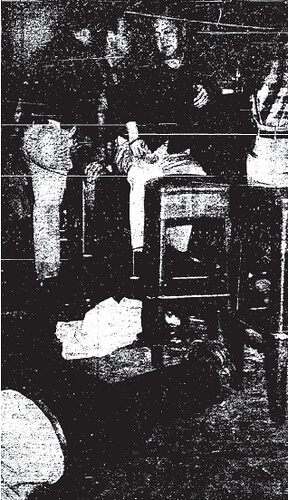
 The scene was a bar at 822 West Third Street, the players, a group of hard-drinking Bunker Hill regulars, but the story would turn tragic on July 22, 1956.
The scene was a bar at 822 West Third Street, the players, a group of hard-drinking Bunker Hill regulars, but the story would turn tragic on July 22, 1956.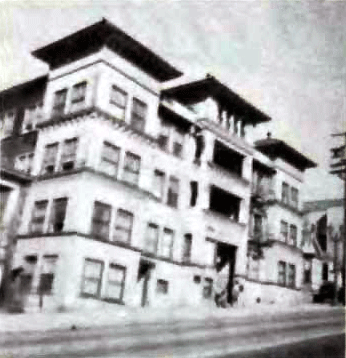
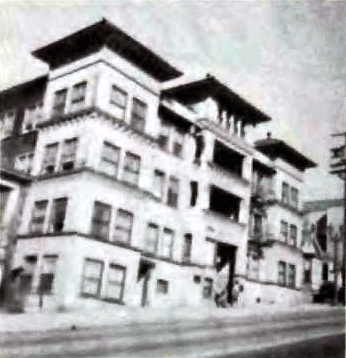 Say “mother fixation” and dollars to donuts you mean, or are taken to mean, a fixation on your mother. Mrs. Emma Rupe was fixated on being a mother. So much so that on July 5, 1936, the Denver waitress took a fancy to John, the two year-old son of Mr. and Mrs. John Richard O‘Brien. John, it seems, looked just like Emma‘s own toddler who‘d died nine years previous. On the pretext that she was going to take the little darling out to buy him a playsuit (the O‘Briens being trusting souls, and near penniless, so how could they refuse?) Emma thereupon took John shopping”¦as far from Denver as she could get, and with as great a chance of disappearing as possible. Because clichés are born of truth, noir clichés especially, she beelined straight for Los Angeles, Bunker Hill specifically, and checked into the St. Regis.
Say “mother fixation” and dollars to donuts you mean, or are taken to mean, a fixation on your mother. Mrs. Emma Rupe was fixated on being a mother. So much so that on July 5, 1936, the Denver waitress took a fancy to John, the two year-old son of Mr. and Mrs. John Richard O‘Brien. John, it seems, looked just like Emma‘s own toddler who‘d died nine years previous. On the pretext that she was going to take the little darling out to buy him a playsuit (the O‘Briens being trusting souls, and near penniless, so how could they refuse?) Emma thereupon took John shopping”¦as far from Denver as she could get, and with as great a chance of disappearing as possible. Because clichés are born of truth, noir clichés especially, she beelined straight for Los Angeles, Bunker Hill specifically, and checked into the St. Regis.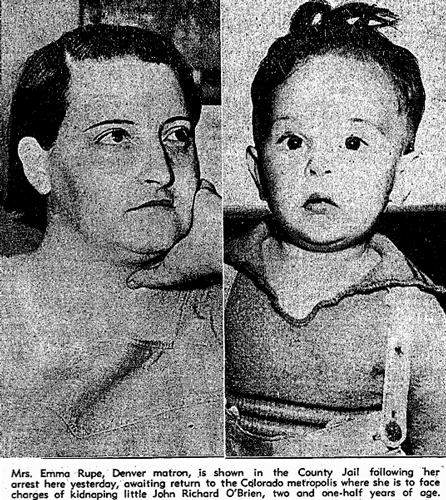
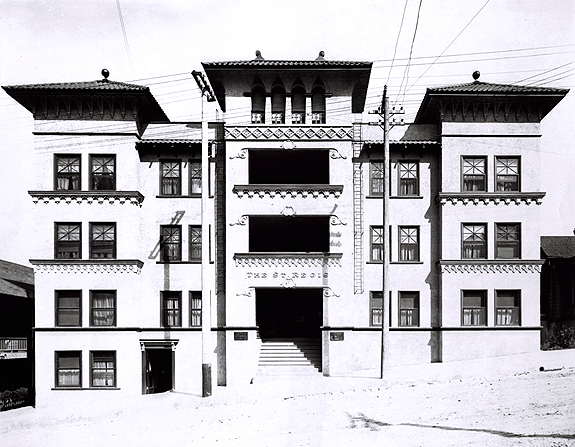
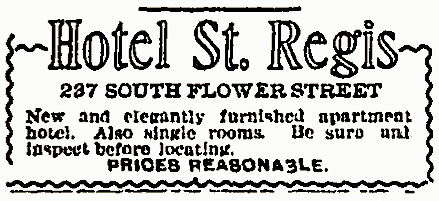
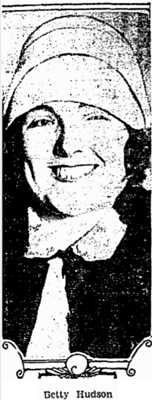
 The early 1960s were no more kind to this little niche of the Hill than any other. The Bozwell Apartments (which seem to shoot for Greek Revival but, oddly, come off as Monterrey) next door at 245, abandoned, burn on May 22, 1962.
The early 1960s were no more kind to this little niche of the Hill than any other. The Bozwell Apartments (which seem to shoot for Greek Revival but, oddly, come off as Monterrey) next door at 245, abandoned, burn on May 22, 1962.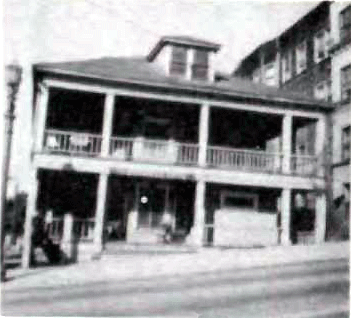

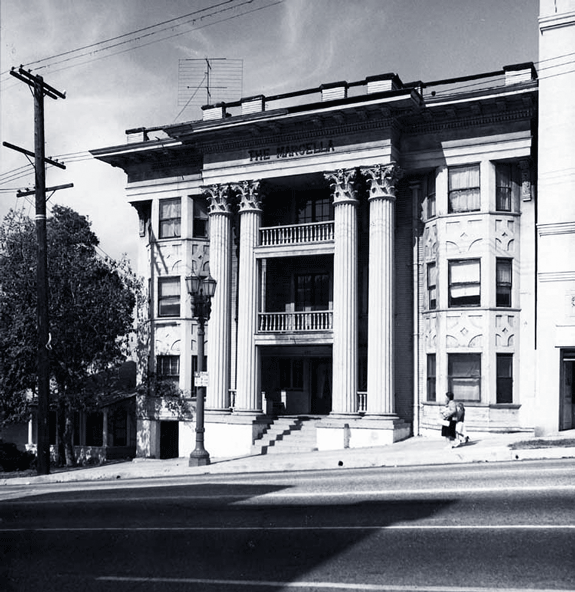
 Today we discuss The Marcella, who once flaunted her classical order on Flower (she is Italian, please be advised the C in her name is not pronounced s as in sell, but like ch as in chin). See how her name beckons, proud but not haughty, from her entablature? She wants to take you in and protect you under that great cornice with her large corbels. Despite her imposing presence, she is warm, and welcoming; the wide porches bespeak grace, and the timberframe vernacular on the bays coo cozy by the fire lad, there‘s good feelings in mortise and tenon.
Today we discuss The Marcella, who once flaunted her classical order on Flower (she is Italian, please be advised the C in her name is not pronounced s as in sell, but like ch as in chin). See how her name beckons, proud but not haughty, from her entablature? She wants to take you in and protect you under that great cornice with her large corbels. Despite her imposing presence, she is warm, and welcoming; the wide porches bespeak grace, and the timberframe vernacular on the bays coo cozy by the fire lad, there‘s good feelings in mortise and tenon. 
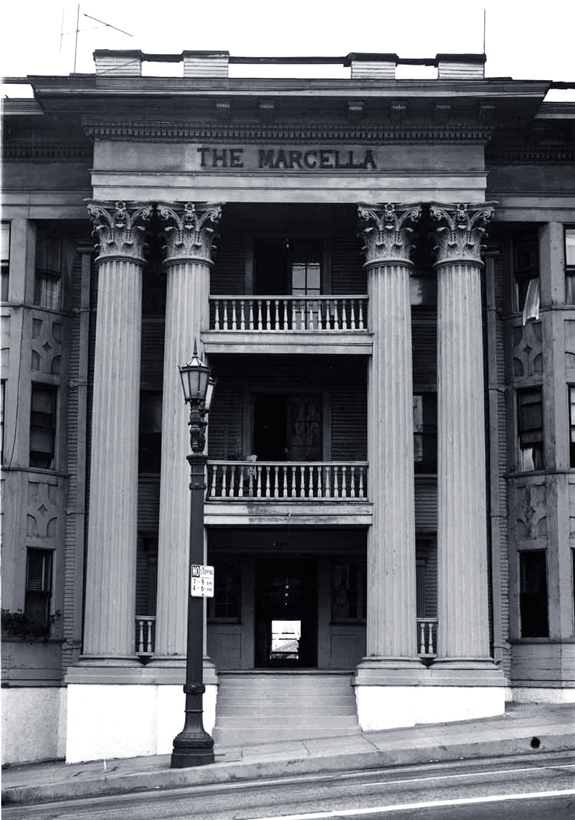
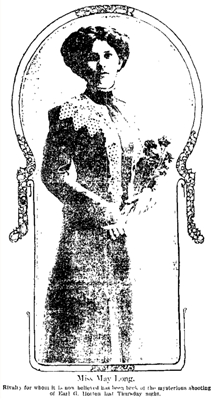

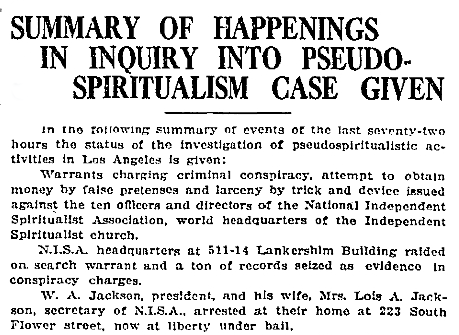
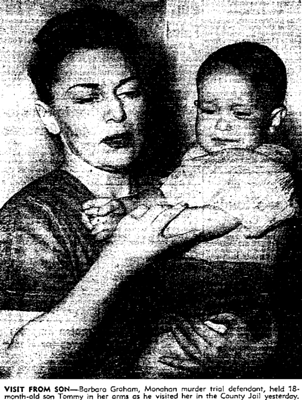



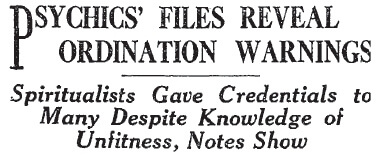

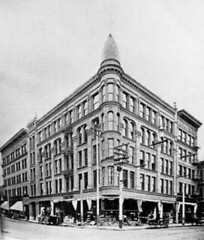 The NISA headquarters were located in the Lankershim Building at 3rd and Spring, and many of those arrested lived right on Bunker Hill.
The NISA headquarters were located in the Lankershim Building at 3rd and Spring, and many of those arrested lived right on Bunker Hill.
 15-year-old Susie Miller was a pretty brunette with a vivacious disposition who loved to play the violin. She also loved Willie Miller, a 15-year-old butcher’s apprentice, and he loved her — the two were already talking about marriage. But Susie’s parents, Mr. and Mrs. Samuel Miller disapproved of the match so strongly that they uprooted the family from their home in San Francisco and moved to Los Angeles in the hopes of squashing the love affair.
15-year-old Susie Miller was a pretty brunette with a vivacious disposition who loved to play the violin. She also loved Willie Miller, a 15-year-old butcher’s apprentice, and he loved her — the two were already talking about marriage. But Susie’s parents, Mr. and Mrs. Samuel Miller disapproved of the match so strongly that they uprooted the family from their home in San Francisco and moved to Los Angeles in the hopes of squashing the love affair.